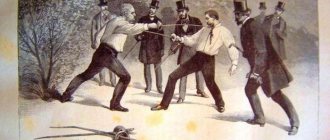A matter of honor
History knows many types of private duels - knightly tournaments, “funny fights”... But a duel has a number of features that distinguish it from other fights.
Heiress of the tournament
It is believed that duels appeared in Europe in the 16th century - after the extinction of knightly tournaments. Their homeland is Italy, but soon the tradition of personal duels spread to France and Germany.
“Duo” means “two,” but duels were not always paired. At the initial stage, there are many fights between large companies. In France, there is a known case of 6 opponents fighting at the same time, and only one survived.
A. Dumas used the precedent to create the final scene in “The Countess de Monsoreau”. But already in the 18th century, duels became a duel between two.
The history of duels in Russia began in 1666. It was an import - the participants were two foreign hired officers. The winner, Patrick Gordon, then became a prominent figure in the Peter the Great era.
Features
In past centuries, a “private” fight was not considered something special. But the duel had a number of characteristics unique to it.
- The reason for the duel is an insult to the honor and dignity (of the participant or a woman close to him). A property dispute or criminal claim was considered by the court.
- A duel is an armed duel. Fighting without weapons was not considered such.
- The challenge and the fight itself had to have witnesses. Meetings in private were rare.
- Opponents were given equal opportunities: the same weapons and conditions. For this reason, before the fight, new weapons were necessarily purchased. Each participant had to have a set “for two”, and whose would be used was decided by lot. If one of the opponents could not fight (was old or sick), he could nominate a deputy (usually a relative or best friend). Such a case is described by Corneille in the Cid.
- The goal was not to kill the enemy, but to prove one’s moral superiority. Although murders were not uncommon.
- Only a duel of equals could be considered a duel. Although they didn't have to be nobles.
- The fight had to have a protocol. This was required to ensure that the participants could not be considered criminals. The protocol could be “on parole,” but more often it was written down.
These were unwritten rules, but they were strictly followed. There were deviations, but more often by agreement of the parties.
Commoner's honor
Usually the participants in the fights were nobles, especially officers. But this was not an immutable rule. For example, the famous Russian politician of the beginning of the last century A.I. Guchkov (of a merchant family, but received nobility according to the Table of Ranks) was known as the most dangerous breter (that is, a fighter).
In Western Europe, student duels have long been extremely popular.
They fought with swords. The participants sought to inflict a wound on the enemy, very lightly, but in a noticeable place, preferably in the face. The goal was not so much to punish the enemy for insulting him, but to prove that you are a fighting guy, and it is better not to touch you.
The more scars a student had on his face, the more he was respected. One thing is important: the opponent of the nobleman was the nobleman, the commoner was the commoner. In Western Europe (but not in Russia), women's duels have been recorded.
Duels in Russia
Home » Smoking room. Anything and everything your heart desires. » Duels in Russia
Smoking room. Anything and everything your heart desires.
comrade Sukhov 02/09/2014 295
1
in Favoritesin Favoritesfrom Favorites 0
Let’s immediately make a reservation about which fights we will talk about. Even in ancient times, judicial duels were known, appointed to resolve disputes on property and other issues (in particular, in “Russian Truth”), circus fights of gladiators in Ancient Rome, medieval knightly tournaments, fist fights in Rus'. But they are not included in the concept of a classic duel. The definition of duality given by the Russian military writer of the beginning of the century P. A. Shveikovsky seems to us to be the most comprehensive and accurate: “A duel is an agreed-upon fight between two persons with a deadly weapon to satisfy the outraged honor, in compliance with certain conditions established by custom regarding place, time, weapons and in general battle conditions." From this definition we can isolate the following main features of a classical duel:
- the purpose of the duel is to satisfy the outraged honor (and not a circus performance, not a resolution of a dispute, and not a competition of strength);
- there are only two participants in the duel (and not “wall to wall”), i.e. the offended person and his offender (hence the very word “duel”);
- the means of dueling are lethal weapons (and not fists, like the merchant Kalashnikov and Kiribeevich);
- the presence of rules (conditions) of a duel established by custom, which must be strictly observed.
We will look at the classic rules of dueling codes next. Now let's look at the origins of duels.
It is known that the duel as a custom came to Russia from the West. But even there it did not exist forever. The origins of the classical duel in Western Europe can be dated back to the late Middle Ages, around the 14th century, when the knightly class - the predecessor of the nobility - was finally formed and flourished, with its concepts of honor, which were largely alien to the commoner or merchant. In the 16th century, duels had already assumed such a threatening scale and claimed so many lives that kings began to fight this custom. Thus, during the 16 years of the reign of Henry IV in France, from 7 to 8 thousand people were killed in duels. The famous Cardinal Richelieu banned duels on pain of death, declaring that a nobleman could sacrifice his life only in the interests of the king. Louis XIV in 1679, by a special edict, established a court of marshals to resolve all issues of honor.
But nothing helped, including the statement that the king took upon himself the insult of everyone who refused the fight. The nobility stubbornly avoided interference by the state and courts in matters of honor. While recognizing the king's right to dispose of their lives and services, it rejected the right to decide issues related to honor and dignity. Throughout history, refusal to fight continued to be considered an indelible shame, forever excluding the person who refused from the society of decent people. Realizing this, the monarchs themselves found themselves shackled, and their fight against duels was always inconsistent. There is a known case when the French king Francis I himself challenged the German emperor Charles V to a duel.
The Swedish king Gustav Adolf, a renowned military leader in the first half of the 17th century, vigorously pursued duels with his decrees. But when the army colonel offended by his slap, unable to call the king himself, left his service and left the country, the king caught up with him at the border and himself handed him a pistol with the words: “Here, where my kingdom ends, Gustav Adolf is no longer a king, and here, as an honest man, I am ready to give satisfaction to another honest man.” His words, like a drop of water, reflect... The whole duality of the attitude of most European sovereigns to a duel was evident: as rulers of their subjects and legislators, they sought to put an end to the bloodshed, but as secular people with the same concepts of honor, they understood that they themselves would behave the same way.
A duel is precisely that most curious incident when morality and law constantly contradict each other, when the concept of protecting honor and dignity with arms in hand collides with the constant desire of the state to regulate these issues by legal means, with the help of the court. Frederick the Great already turned a blind eye to duels in his army. By the second half of the 19th century, duels became so ingrained that people learned to look at them as an inevitable evil, bans began to be lifted everywhere, and in the army duels were even legalized through the courts of officer honor. France has always been the legislator of the customs and rules of dueling. In 1836, the Comte de Chateauvillard published the dueling code for the first time. Later, the dueling code of Count Verger, published in 1879 and summing up the experience accumulated over centuries in conducting duels, became generally recognized in Europe. He was recognized as a model in Russia.
What was the historical path of dueling in our Fatherland?
Presumably the first duel in Russia can be considered a duel that took place in 1666 in Moscow between two hired foreign officers - the Scotsman Patrick Gordon (later Peter's general) and the Englishman Major Montgomery. But at that time this custom had not yet penetrated among Russians. Nevertheless, isolated precedents forced Princess Sophia to stipulate a ban on fights in her decree of October 25, 1682, which allowed all service people of the Moscow state to carry personal weapons. Peter the Great, energetically instilling European customs in Russia, hastened to prevent the spread of duels with cruel laws against them.
Chapter 49 of Peter’s Military Regulations of 1715, called “Patent on duels and starting quarrels,” proclaimed: “No insult to the honor of the offended person can in any way belittled,” the victim and witnesses to the incident are obliged to immediately report the fact of insult to the military court; failure to report was also punishable. The challenge to a duel itself was punishable by deprivation of rank and partial confiscation of property; for entering a duel and drawing a weapon - the death penalty with complete confiscation of property, not excluding seconds.
The “Military Article” of 1715, published as an appendix to Peter’s regulations, stated even more clearly on this score, in which two articles were devoted to duels. The first of them (“article 139”) stated: “All challenges, fights and duels through cue are most strictly prohibited. Thus, so that no one, no matter who he is, of high or low rank, born local or foreigner, although anyone else, who was prompted and excited by words, deeds, signs or anything else, does not at all dare to challenge his rival, below in a duel with him, fight with pistols or with swords. Whoever does anything against this, of course, both the caller and whoever comes out, will be executed, namely hanged, although any of them will be wounded or killed... then after death they will be hanged by the feet.”
The next article (“Article 140”) stipulated the same thing about seconds: “If someone quarrels with someone and begs the second,” then the second “should be punished in the same way.” Like VidicT, the punishments for the fight were meted out in the typically Peter the Great, mercilessly cruel style. Despite this, Peter’s laws against combat, which were formally in force until 1787, were never applied in all these seventy years. What's the matter?
And the fact is that the very concept of honor in its European meaning had not yet entered the consciousness of the Russian nobility, and there were practically no duels until the second half of Catherine’s reign. We should not forget that Peter’s innovations in relation to Western customs and morals were too superficial; for the most part, the Russian nobility in terms of education and internal culture for a long time was not much different from the common people, and the desire to wash away the violation of honor with blood in a fair fight was alien to it. In addition, there was still exceptionally great fear of reprisals from the state; until 1762, the ominous “word and deed” was in effect.
Therefore, when duels began to spread among noble youth in Catherine’s era, representatives of the older generation reacted to this with unconditional condemnation. D.I. Fonvizin in “A sincere confession of my deeds and my thoughts” recalled that his father considered a duel “a matter against conscience” and taught him: “We live under laws, and it is a shame, having such sacred defenders, to figure out what the laws are for ourselves with fists or with swords, for swords and fists are one thing, and a challenge to a duel is nothing more than the action of wild youth.” And let us remember how Pyotr Grinev, the hero of Pushkin’s “The Captain’s Daughter,” was reprimanded by his father Andrei Petrovich Grinev in his letter for his duel with Shvabrin: “... I’m going to get to you and teach you a lesson for your pranks like a boy, despite your officer rank: for you have proven that you are not yet worthy to carry a sword, which was granted to you for the defense of the fatherland, and not for duels with the same tomboys as you yourself.”
Nevertheless, duels gradually penetrated more and more among noble youth. And the reason here was not so much the “spirit of exuberant youth,” which law-abiding fathers disapprovingly reproached their children for, but rather the emerging sense of honor and personal dignity, which developed gradually, with the development of education and class upbringing, and intensified with each new generation. The noble youth, still faithful to the oath and the throne, did not allow the state to interfere in matters of honor. Later, General Kornilov succinctly and succinctly expressed this formula in his life credo: “The soul is for God, the heart is for a woman, duty is for the Fatherland, honor is for no one.”
By the time duels became widespread in Russia, the formidable articles of Peter the Great’s article, which punished death for a duel, had been thoroughly forgotten, since sixty years had passed since their publication. And the “powers that be” are faced with a problem: how to deal with duels? In 1787, Catherine the Great published the “Manifesto on Duels.” In it, duels were called a foreign plant; participants in a duel that ended bloodlessly were given a fine as a punishment (not excluding seconds), and the offender, “as a violator of peace and tranquility,” was given lifelong exile to Siberia. For wounds and murder in a duel, punishment was imposed as for the corresponding intentional crimes. The duel reached its apogee in the first half of the 19th century. The prohibition of duels was reaffirmed in the Code of Criminal Laws published under Nicholas I in 1832 and the Military Criminal Charter of 1839, which obligated military commanders to “try to reconcile those quarreling and provide the offended with satisfaction by exacting punishment from the offender.”
But nothing helped! Moreover, duels in Russia were distinguished by the exceptionally strict conditions of the unwritten codes: the distance ranged from 3 to 25 steps (most often 15 steps), there were even duels without seconds and doctors, one on one, they often fought to the death, sometimes they shot while standing one by one with his back at the edge of the abyss, so that if he gets hit, the enemy does not survive (remember the duel between Pechorin and Grushnitsky in “Princess Mary”). Under such conditions, both opponents often died (as happened in 1825 in the duel between Novosiltsev and Chernov). Moreover, regimental commanders, formally following the letter of the law, actually themselves encouraged such a sense of honor among officers and, under various pretexts, released those officers who refused to fight in a duel.
At the same time, Nicholas I personally treated duels with disgust; his words are known: “I hate duels. This is barbarism. In my opinion, there is nothing chivalrous about her. The Duke of Wellington destroyed it in the English army and did well.” But it was precisely in the 20-40s of the 19th century that the high-profile duels of Pushkin with Dantes, Ryleev with Prince Shakhovsky, Griboedov with Yakubovich, Lermontov with de Barant and Martynov took place.
The text of the terms of the duel between Pushkin and Dantes has reached posterity. For illustration, we present it in full:
“Rules of the duel between Mr. Baron Georges Heeckeren and Mr. Pushkin.
- Opponents are placed at a distance of 20 steps from each other and 10 steps from the barriers, the distance between which is 10 steps.
- Opponents armed with pistols, following this sign, moving towards each other, but in no case crossing the barrier, can shoot.
- Moreover, it is accepted that after a shot, opponents are not allowed to change place, so that the one who fired first would be exposed to the fire of his opponent at the same distance.
- When both sides fire a shot, then in case of ineffectiveness the fight is resumed as if for the first time, the opponents are placed at the same distance of 20 steps, the same barriers and the same rules are maintained.
- Seconds are direct intermediaries in every relationship between opponents on the spot.
- The seconds, the undersigned and vested with full powers, ensure, each on his side, with his honor, strict compliance with the conditions stated here.
January 27, 1837. 2 1/2 hours in the afternoon.
Signed:
Viscount d'Archiac, seconded to the French embassy
Konstantin Danzas, engineering lieutenant colonel."
There were people who showed rare fearlessness and fortitude in a duel. Thus, Pushkin, in a duel with officer Zubov in 1822 (in Chisinau), while waiting for the enemy’s shot, calmly ate cherries and spat the pits in his direction, which infuriated his counterpart. Pushkin later used these cases when creating the story “The Shot”. The Decembrist M.S. Lunin showed true recklessness, as if he was consciously seeking death and playing blind man's buff with it. Once, according to contemporaries, Grand Duke Konstantin Pavlovich undeservedly insulted the officers of the Cavalry Regiment, but then apologized, adding that if any of the officers considered himself offended, then he was ready to give satisfaction. Suddenly desperate Lunin volunteered:
“Your Highness, the honor is so great that I only fear one thing: none of my comrades will agree to cede it to me.” The scandal, of course, was hushed up, but Konstantin liked the bold answer, and subsequently he took Lunin as his adjutant. Lunin’s duel with his fellow soldier Count A.F. Orlov, later the chief of gendarmes and Benckendorff’s successor, is also known. In fact, Lunin, a brute and a bully, himself provoked Orlov into a duel. Knowing that Orlov was a poor shooter and Lunin a virtuoso, witnesses to the fight had no doubt about its outcome. But Lunin... only cold-bloodedly mocked Orlov (like Pushkin’s Silvio at the count). According to an eyewitness's description, they shot at 12 paces. Orlov fired and missed. Lunin fired into the air and sarcastically suggested that the enemy try his luck again, while teaching him how to aim. The enraged count shouted: “What are you doing! Are you laughing at me?” - and fired another time, shooting through Lunin’s cap. Lunin fired into the air again, continuing to joke and vouching to Orlov for the success of the third shot. Then they were stopped by their seconds...
With the advent of relative freedom of the press in Russia in the second half of the 19th century, the controversy surrounding the duel transferred to its pages. Opinions were divided between supporters of the duel and its opponents. Among the first, the jurists Lokhvitsky, Spasovich, military writers Kalinin, Shveikovsky, Mikulin stood out; in the opposing camp there were no less respectable names: military leader, teacher and writer General M.I. Dragomirov, military lawyer Shavrov. The point of view of the supporters of the duel was most clearly expressed by Spasovich: “The custom of the duel is among civilization as a symbol of the fact that a person can and should, in certain cases, sacrifice his most precious good - life - for things that, from a materialistic point of view, have no meaning and meaning: for faith, homeland and honor. That is why this custom cannot be compromised. It has the same basis as war.”
Even under Emperor Nicholas I, according to the “Code on Criminal Punishments” of 1845, liability for duels was significantly reduced: seconds and doctors were generally exempt from punishment (unless they acted as instigators), and the punishment for duelists no longer exceeded - even in the event of death one of the opponents - imprisonment in a fortress from 6 to 10 years with retention of noble rights upon release. This provision once again reflected the inconsistency of the legislation on duels. In practice, these measures were never applied - the most common punishment for duelists was transfer to the active army in the Caucasus (as was the case with Lermontov for the duel with de Barant), and in the event of death - demotion from officers to privates (as was the case with Dantes after the duel with Pushkin), after which they, as a rule, were fairly quickly restored to officer rank.
The courts of the society of officers were to become a new milestone at this stage. Officer society courts by that time existed in many European armies, playing the role of something like comradely courts. In the Russian army they existed semi-officially from the time of Peter the Great (since 1721). The Society of Regimental Officers could issue certifications to officers and was a significant instrument of public opinion in the military environment. They especially flourished under Alexander I, after 1822, when the emperor himself, when analyzing the conflict between the court of the society of officers and the regiment commander, sided with the former. But in 1829, Nicholas I saw in the very fact of the existence of independent officer corporations, endowed with considerable rights, a means of undermining military discipline and banned their activities everywhere. Nevertheless, this measure, at first glance reasonable, in practice turned out to be erroneous, since the courts of the society of officers were a powerful means of moral, educational influence. Therefore, during the period of the “great reforms” of the 60s, they were (in 1863) restored and acquired official status. A regulation was issued on their structure (in the navy - since 1864 - courts of captains, in each naval division). When developing this provision, many proposed to delegate to the discretion of these courts the issues of resolving a duel in each specific case, but this proposal was rejected. Nevertheless, the punishments for fights became more and more lenient.
Thus, the Senate’s ruling in the case of the duel between Beklemishev and Neklyudov in 1860 stated: “The title of the criminal and his degree of education cannot have any influence in judging cases of duels (usually, when considering criminal cases, the education and good origin of the criminal were an aggravating circumstance. - V.Kh.), because this crime is so connected with a concept characteristic exclusively of educated people that the indicated circumstances seem in this case to be rather a reason explaining, and therefore reducing, crime.” There were also tragicomic cases. One of them is described in his “Notes of a Revolutionary” by Prince P. A. Kropotkin. A certain officer was insulted by Alexander III even when he was heir to the throne. Being in an unequal position and unable to challenge the crown prince himself to a duel, the officer sent him a note demanding a written apology, otherwise threatening suicide. If the heir had been more sensitive, he would have apologized or given satisfaction to the person who did not have the opportunity to call him. But he didn't. After 24 hours, the officer fulfilled his promise exactly and shot himself. The angry Alexander II sharply reprimanded his son and ordered him to accompany the officer’s coffin at the funeral.
Finally, in 1894, at the very end of the reign of Alexander III, fights were officially allowed. Order No. 118 of the military department dated May 20, 1894, entitled: “Rules on the resolution of quarrels that occur among officers,” consisted of 6 points. The first point established that all cases of officer quarrels were sent by the commander of the military unit to the court of the officers' society. Point two determined that the court could either recognize the possibility of reconciliation between the officers, or (due to the severity of the insults) rule on the need for a duel. At the same time, the court’s decision on the possibility of reconciliation was advisory in nature, while the decision on the duel was mandatory. Point three stated that the specific conditions of the duel were determined by the seconds chosen by the opponents themselves, but at the end of the duel, the court of the society of officers, according to the protocol presented by the senior second-manager, considered the behavior of the duelists and seconds and the conditions of the duel. Point four obliged the officer who refused the duel to submit a request for resignation within two weeks; otherwise, he was subject to dismissal without request. Finally, paragraph five stipulated that in those military units where there are no officers’ society courts, their functions are performed by the commander of the military unit himself.
In addition to this, the order for the military department No. 119 of May 21, 1894 obliged the courts of the society of officers to “decide the removal of unworthy officers from the unit ... when it is discovered that the officer, while defending his honor or giving satisfaction to the insulted, did not show a true sense of honor and personal dignity, but showed an effort to comply with only one form.” Article 553 of the “Charter of Military Judicial Procedure” and later (in 1906) Article 1243 of the “Charter of Criminal Proceedings” were supplemented with notes that determined the procedure for sending cases of duels to higher authorities: each case of a duel, equipped with a conclusion of the military district prosecutor’s supervision and materials court of the society of officers, was forwarded by the Minister of War (or Navy) together with the Minister of Justice for a report to the highest name as an emergency incident. In 1894-1896, draft dueling codes were developed first by Lieutenant General A. A. Kireev, then by a commission chaired by cavalry general A. P. Strukov, and finally by a commission headed by cavalry general D. P. Dokhturov.
But in the end, the publication of legislative rules for dueling was considered inconvenient, and unwritten rules established by custom remained, that is, a kind of legal nonsense. As before, only the challenge of a superior to a subordinate or a senior junior to a duel in cases related to service was punishable (Articles 99 and 100 of the “Military Regulations on Punishments”). Such challenges were punishable by deprivation of rank and exclusion from service, or imprisonment in a fortress for up to 4 years, or demotion to the ranks; at the same time, the boss or senior who accepted such a challenge was also subject to punishment. But - let us emphasize this again - this only applied to calls on official business; For personal grievances that did not relate to service, it was also allowed for subordinates to challenge their superiors and officers to call generals. In 1912, the courts of the society of officers were renamed courts of honor, and by order of the military department No. 81 of February 6, 1912, a new, 14th chapter was included in the military “Disciplinary Charter” - “On the court of honor”, which included 50 articles (with 130th to 179th).
Article 130 of this Charter clearly defined the functions of the courts of honor: “Courts of honor are established to protect the dignity of military service and maintain the valor of the officer rank. They are entrusted with: a) consideration of offenses that are incompatible with the concepts of military honor, service dignity, morality and nobility; and b) analysis of quarrels that occur among officers.” Articles 175, 176, 177 and 178 repeated the duties of the court of honor set out in orders for the military department Nos. 118 and 119 of 1894 in relation to duels: a decree on reconciliation or a duel (here it was added: in case of discovery of unseemly acts as one of the reasons quarrels - conducting an inquiry), dismissal from service for refusing a duel within two weeks, analysis of the behavior of duelists and seconds and the conditions of the duel (retroactively), etc. Moreover, if the opponents served in different regiments and there were differences in court decisions honor of these regiments, the last word was given to the court of honor of the regiment where the insulted served. Reserve officers were also obliged to protect his honor while wearing a uniform. The following were considered incompetent for a duel (whose challenge could not be accepted and who was not accepted to be challenged):
- persons disgraced in public opinion (sharps; those who previously refused a duel; those who filed a complaint against the offender in a criminal court);
- crazy;
- minors, i.e. those under 21 years of age (except for married people, students and employees - in general there was no clear boundary);
- persons who stood at low levels of public culture (i.e., as a rule, representatives of the common people);
- debtors in relation to their creditors; close relatives (up to and including uncles and nephews);
- women.
Her natural patron (husband, father, brother, son, guardian, close relative) was obliged to protect the honor of a woman; but at the same time, a necessary condition for the admissibility of a duel over a woman was her moral behavior - that is, a woman known for her easy behavior was rightly not recognized as having the right to protection from insults. According to the rules, a challenge to a duel was sent 24 hours after the court’s decision, and a response was sent 24 hours after receiving the challenge. At the same time, delay in calling was not considered an obstacle to the duel. It was also obligatory to accept the duties of a second upon invitation. As a rule, each of the opponents chose two seconds (but they could also have one) - from mature people, who were not interested in the case and not close relatives (uncles and nephews were still excluded, cousins were already allowed; the same thing happened with challenges to a duel). Finally, there was an immutable custom according to which one could be challenged to a duel only once for the same insult.
The most difficult question has always been the question of the severity of the insults inflicted. There have always been disagreements on this matter. For example, M.I. Dragomirov, who looked rather skeptically at such things, noted in his brochure “Duels”:
“Assault while drunk is not a disgraceful assault (that is, not an insult to honor), but a nasty folk habit... If (this) happened in a completely limited circle of comrades, and the people are decent, there is no point in gossiping and ranting.” It was generally accepted to conventionally divide insults sufficient for a duel into three categories:
- light - if the insult, although particularly caustic, affects unimportant aspects of the personality - appearance, manners, habits, etc.; in this case, the insulted person could only choose the type of weapon;
- moderate severity - if it is combined with abuse; then the offended person could choose the type of weapon and the type of duel (until first blood, until a serious wound, until death);
- severe - if the insult was accompanied by assault or especially serious, defamatory accusations; in this case, the victim chose the type of weapon, the type of duel and set the distance.
The offended person lost the right to choose weapons, etc., if his opponent apologized and he did not accept the apology. It was not allowed to replace one duelist with another, his attorney, unless the first was able to fight. The seconds could reject bladed weapons if their client was one-legged or without a right arm, and could also reject pistols if he was one-eyed and inflicted a slight insult. By the way, when choosing a bladed weapon, it was most difficult for the seconds to regulate the course of the fight due to its mobility and stimulating effect on opponents; In addition, in duels with edged weapons, the inequality of those fighting in such a complex art as fencing has always had a stronger effect. Therefore, duels with edged weapons were not widespread. A prerequisite for a duel was that the opponents had identical weapons - in length, sharpness of the sword or saber, strength of combat and brand of pistol. The seconds were obliged to carefully check the fighting qualities of the weapon before the start of the duel; Moreover, during a pistol duel, the brand of the pistol should not have been known to the opponents in advance. A pistol (according to established tradition - a smooth-bore weapon) was considered a dueling firearm; a cold weapon - an epee, saber, checker, broadsword, espadron.
The unwritten order of the duel was as follows. At a predetermined time (usually in the morning), opponents, seconds and a doctor arrived at the appointed place. Delay was allowed no more than 15 minutes; otherwise, the latecomer was considered to have evaded the duel. The fight usually began 10 minutes after everyone arrived. Opponents and seconds greeted each other with a bow. The steward, chosen by the seconds from among himself, suggested that the duelists make peace for the last time (if the court of honor recognized this as possible). If they refused, the manager explained to them the conditions of the fight, the seconds marked the barriers and loaded the pistols in the presence of the opponents. When dueling with sabers or swords, opponents undressed from the waist down to their shirts. Everything was supposed to be taken out of the pockets. The seconds took places parallel to the battle line, the doctors - behind them. The opponents performed all actions at the command of the manager. If during the duel one of them dropped his sword, either it broke, or the fighter fell, his opponent was obliged to interrupt the duel at the command of the manager until his opponent stood up and was able to continue the duel. As a rule, a sword duel was fought until one of the opponents completely lost the ability to continue it - that is, until he was seriously or fatally wounded. Therefore, after each wound, the fight was suspended, and the doctor established the nature of the wound and the degree of its severity. If during such a duel one of the opponents, despite warnings, retreated three times outside the battlefield, such behavior was counted as evasion or refusal of a fair fight. At the end of the fight, the opponents shook hands with each other.
Pistol duels had several options.
Option 1. The opponents stood at a distance of 15 to 40 steps from each other and, remaining motionless, took turns shooting on command (the interval between the command and the shot had to be at least 3 seconds, but no more than 1 minute). If the insult was medium or severe, then the insulted person had the right to shoot first (but only from a distance of 40 steps, i.e. maximum), otherwise the right to fire the first shot was decided by lot.
Option 2 (relatively rare). The opponents stood with their backs to each other at a distance of 25 steps and, remaining motionless at this distance, continuously fired over their shoulders.
Option 3 (perhaps the most common). The opponents stood at a distance of up to 30 steps from each other and, on command, walked towards barriers, the distance between which was at least 10 steps; on command, the first one fired on the move, but waited for a return shot while standing still (shooting without a command was allowed if the barriers were 15-20 steps apart from each other, and the opponents in the starting position were up to 50 steps apart; but this is a relatively rare variety). In such a duel, the time for a return shot did not exceed 30 seconds, for the fallen one - 1 minute from the moment of the fall. It was forbidden to cross the barriers. A misfire was also considered a shot. The fallen man could shoot while lying down (as the wounded Pushkin shot at Dantes). If during such a duel, after four shots, none of the opponents was wounded, then it could be stopped.
Option 4. Opponents stood at a distance of 25-35 steps, positioned along parallel lines, so that each of them had his own opponent to his right, and walked along these lines to barriers spaced 15 steps apart, stopping and shooting on command .
Option 5. The opponents were located at a distance of 25-35 steps and, remaining motionless, fired simultaneously - on command for the count of “one-two” or on a signal of three claps. Such a duel was the most dangerous, and both opponents often died (the duel between Novosiltsev and Chernov). At the end, the opponents shook hands with each other.
Note that these rules (at least the same distance), established by the end of the 19th century, were in many ways more humane than the usual rules of Russian duels of the first half of the 19th century. It is curious that if in the second half of the 19th century the number of duels in the Russian army clearly began to decline, then after official permission in 1894 their number again sharply increased.
For comparison: from 1876 to 1890, only 14 cases of officer duels came to trial (in 2 of them the opponents were acquitted); from 1894 to 1910, 322 duels took place, of which 256 were decided by courts of honor, 47 with the permission of military commanders, and 19 unauthorized (none of them reached a criminal court). Every year there were from 4 to 33 fights in the army (on average - 20). According to General Mikulin, from 1894 to 1910 the following took part in officer duels as opponents: 4 generals, 14 staff officers, 187 captains and staff captains, 367 junior officers, 72 civilians. Of the 99 insult duels, 9 ended with a serious outcome, 17 with a slight injury and 73 with no bloodshed. Of the 183 serious insult duels, 21 ended with a serious outcome, 31 with a slight wound and 131 with no bloodshed. Thus, a small number of fights ended in the death of one of the opponents or serious injury—10-11% of the total. Of all 322 duels, 315 took place with pistols and only 7 with swords or sabers. Of these, in 241 fights (i.e. in 3/4 of the cases) one bullet was fired, in 49 - two, in 12 - three, in one - four and in one - six bullets; the distance ranged from 12 to 50 steps. The intervals between the insult and the fight ranged from one day to... three years (!), but most often - from two days to two and a half months (depending on the duration of the case review by the court of honor).
So at the beginning of our century, duels were a fairly common occurrence in Russia. The well-known political figure and leader of the Union of October 17, A. I. Guchkov, fought in a duel more than once, even gaining the glory of being a brigand (although he himself was by no means of noble origin). Ilya Erenburg in his memoirs “People, Years, Life” describes a duel between two famous poets - Nikolai Gumilyov and Maximilian Voloshin - in the pre-revolutionary years, the reason for which was one of the pranks that Voloshin was a great master at; During the fight, Voloshin fired into the air, and Gumilyov, who considered himself insulted, missed. By the way, a shot in the air was allowed only if the person challenged to the duel fired, and not the one who called - otherwise the duel was not recognized as valid, but only as a farce, since none of the opponents exposed themselves to danger.
Then different times came. The best representatives of the Russian intelligentsia and officers, with their scrupulous concepts of personal honor, were thrown overboard by the revolution and found themselves in a foreign land. In the proletarian state, such concepts as honor and duty were initially declared relics of the exploitative past. Duels were replaced by denunciations, the concept of state benefit overshadowed everything else, nobility was replaced by the fanaticism of some and the prudence of others.
https://www.gumer.info/bibliotek_Buks/History/Article/Hand_DuelRoss.php
Court of the society of officers and duel in the troops of the Russian Army. https://www.adjudant.ru/officer/honor00.htm
V. Durasov - 1912 Saint Petersburg. Duel. Dueling Code. https://ru.scribd.com/doc/78233873/Dueling-code-V-Durasov
source: Khandorin V. Rodina magazine. 1993, No. 10, p. 87-93
(Vladimir Gennadievich Handorin (June 25, 1964, Seversk, Tomsk region) - Russian historian, blogger, publicist, Doctor of Historical Sciences, Associate Professor, Professor (PSTGU). The main direction of professional activity is researching the history of the Civil War and the White movement in Siberia, Russian liberalism. Author of more than 40 scientific works.)
The right to choose
It was always provided to the participants in the duel. How much depended on their status. We chose a weapon, a place, a method of action. The offended person had more rights, but everything depended on the severity of the conflict.
One of the participants could refuse the fight. But this was fraught with consequences. Without them, only the offended, having received an apology, recalled the call.
A cowardly offender could be boycotted or fired from service. The presence or absence of a ban on dueling did not play a role.
There were exceptions. Thus, the famous gunsmith S.I. Mosin twice sent a challenge to the husband of his beloved woman, and both times he... reported a potential enemy to the appropriate authorities!
Weapon Selection
This right was granted to the offended. Until the 18th century, bladed weapons were usually used - saber, rapier, sword. The blades had to be of equal value, the same length or taking into account the height of the fighters. There were mentions in history of oddities, such as the use of candelabra.
19th century dueling codes favored pistols. Only new, identical in characteristics, smooth-bore samples were used.
After the meeting, the opponents could keep the weapons for themselves. But they no longer had the right to fight him again. Sometimes they agreed on the use of several types of weapons.
Selecting a location
Except for particularly severe cases, this issue was resolved jointly. A fairly well-known, but deserted and remote place was required. Therefore, there were areas where duels took place regularly (Pré-au-Claire in Paris or the same Black River).
If the offense was very serious, they could use a place that was dangerous for the fallen person (the seashore or an abyss). Then even a slight wound threatened opponents with death.
But this happened infrequently; during a duel, the main goal was rarely to kill. You couldn't be late for the fight. A delay of a quarter of an hour was considered evasion.
To the barrier
We also had to choose a way to conduct the fight. It was possible to fight with edged weapons while standing still or moving, as in a normal battle. Pistols provided even better room for maneuver. There were several possibilities for using them.
- Stand motionless and shoot at a signal from a certain distance (measured in steps).
- Stand motionless with your back to the enemy and shoot over your shoulder at random.
- Disperse a certain number of steps, and then, on command, converge to a certain point. The shot could be made at this mark (barrier) or on the move.
- Converge gradually, making the agreed number of stops to shoot. Moreover, each enemy who had already fired a bullet had to wait until the second one did the same.
- Load only one pistol, choose a weapon by lot, put the muzzles to each other's foreheads and pull the triggers. How will fate decide...
There were other options. Thus, in America, “hunts” were practiced, when opponents with the same weapons (they were previously searched) were launched into a certain place (a ravine, a grove, a house). They could do whatever they wanted there until the charges ran out.
This is what the duel between Maurice Gerald and Captain Colquhoun looks like in The Headless Horseman. In serious cases, Russians shot “through a scarf.” The distance was determined by the length of the outstretched arms of the participants, grasping the corners of one handkerchief. It was impossible to miss.
Without bureaucracy
The stages of the duel were necessarily documented. The challenge had to be made publicly (by cursing the enemy, throwing a glove in his face, or slapping him in the face) or in writing.
If one person received several challenges, a strict lot was held, or the person summoned chose his own opponent (to prevent reprisals from many against one). The terms of the meeting were also written down and signed by the participants.
This was to prevent crimes under the guise of honor duels. Sometimes this rule was violated at the risk of the participants. More often this was done when they were going to fight to the death, or in the era of the prohibition of skirmishes. There were also disguised murders - the criminal called out an obviously weaker enemy.
Mandatory participants
Although only 2 people were supposed to participate in the battle itself, there were usually a lot of people at the place where the duel took place. Witnesses kept order and provided assistance to the participants.
Ambulance
If death was not expected, the presence of a doctor was required. Sometimes they brought two - from each side. During the era of banning fights, it was agreed that doctors would not tell the authorities the true cause of their patients' injuries.
Doctors had to save the lives of those seriously injured and determine whether the wounded fighter could continue the fight. They often confirmed death...
Be my second
The most important participant in the duel is the second. This person usually became the best friend or relative of the participant, and was not directly related to the conflict.
Once a challenge had been issued, the opponents should not communicate. All negotiations were conducted by seconds (1-2 from the side). They also had to check the weapons, measure the distance if necessary and monitor the opponents' compliance with the rules.
Sometimes a steward (the most senior and respected among the seconds or simply a respectable person) was selected from among them or additionally. The manager checked that there were no violations, did everything necessary to reconcile the warring parties, and gave signals for the beginning and end of the fight.
It was not safe to be a second. Anti-dueling laws punished them almost as severely as the participants. There have been worse cases. So, in 1870 in Paris, Prince Pierre Bonaparte, a cousin of Emperor Napoleon III, shot and killed 20-year-old journalist Victor Noir.
The young man came to him as a second for his friend, Pascal Grousset (known as a friend and co-author of J. Verne, writer Andre Laurie). He challenged the prince to a duel for grossly insulting the Corsican socialists (Grousset was a Corsican and a revolutionary). The dueling code is not criminal. The prince was acquitted...
Did you call the hireling?
Since then, the rules for conducting judicial duels have been strictly stipulated by Russian legislation, and the authorities have closely monitored their compliance. For example, in the 1229 agreement between Smolensk and Riga, a separate clause noted that the Russian prince should not interfere in the fights of foreigners on Russian territory, and the foreigners pledged not to interfere with the Russian people. A number of measures were taken to ensure that legal battles ended in the death of participants as rarely as possible. According to the Novgorod court charter of the 15th century, opponents necessarily fought in armor and with clubs, and the battle was personally observed by the mayor - the elected head of the Novgorod Republic. According to the Pskov Judicial Charter, the battle took place in full armor, but the bailiffs watching the fight, if they saw a clear loss of one of the parties, could stop the battle at any time in order to avoid the death of the vanquished. Do you think dueling is not child's play? Anywhere, but not in Rus'! There were no restrictions on age or gender: even a child, an old man or a woman had the right to challenge. The law only carefully monitored the fair balance of forces of opponents. If, for example, a dispute was between a healthy man and a woman (an old man, a disabled person, a monk, a child), the latter had the right to put in his place an invited fighter, either a relative or a mercenary. There was a whole profession: people called hirelings, for a certain fee, were ready at any time to go into the “field” instead of the employer. But if a conflict arose between equal rivals, for example between two women, hiring outsiders was prohibited - the plaintiff and defendant had to go to “God’s court” themselves.
The ban is not a hindrance
In the 17th century in Europe, duels became so widespread that they began to significantly reduce the number of nobility. Related to this are attempts to get rid of them. The attempt made by Cardinal Richelieu is quite well known.
What happened to him was exactly what is described in “The Three Musketeers” - the number of fights only increased.
There was even an impudence that, out of principle, he arranged a duel right under the windows of the formidable minister. The insolent man was executed, but the nobles continued to fight, if only to spite the cardinal.
Petrovsky Charter
Peter the Great was in no hurry to import its shortcomings from Europe. A special charter prohibited them from fighting in Russia under penalty of death for all participants!
It turned out no better than Richelieu's. The nobles still considered it, in many cases, a matter of honor to wash away an insult with blood.
The law prohibiting fights was applied several times, but was able to only slightly reduce their number.
Subsequently, Russian emperors repeatedly made attempts to stop these outrages in Russia, but with the same success. Catherine II threatened to exile the bullies to Siberia - and only slightly reduced the number of fights. Nicholas I was a resolute opponent of duels, but during his reign Pushkin and Dantes and Lermontov and Martynov fought.
Society did not support the rulers on this issue. The duelists were helped to disguise the fights, senior officers tried to get rid of subordinates who evaded satisfaction, and their comrades obstructed them, forcing them to resign.
Exile to the active army or demotion to soldiery, practiced as punishment for a duel in the mid-19th century, was perceived by many as a reward, recognition of courage. Such “punished” people received ranks and orders faster than others. There were also fans of duels among the emperors, for example, Paul I.
Mandatory battle
Emperor Alexander III took a different path. In 1894, he lifted the bans and introduced official rules for organizing duels among officers. Any dispute had to be first considered by the officers' council. If he ruled that it was better for the opponents to make peace, they might obey, or they might not.
If it was decided that a fight was obligatory, the one who refused was immediately dismissed from the army.
This decision increased the number of duels, but not the number of deaths. In general, in Russia, shooting intentionally past, or even into the air, was considered a worthy deed. Alexander's decrees were abolished along with the monarchy.
Interesting Facts
Few people know that Dantes, who was excommunicated from noble society after the duel with Pushkin, was ostracized not because of the murder of the famous poet, but because he violated the rules of a duel.
The fact is that after the descent began and Dantes shot, Pushkin, having been wounded, dropped the pistol, which failed when it fell into the snow. It is worth noting that the rules of the duel prohibited any of the fighters from changing weapons during the fight.
But Pushkin demanded that the pistol be replaced and Dantes allowed him to do so. After Alexander Sergeevich’s shot, Dantes fell, but the wound was slight.
The thing is that in a duel they usually took two pairs of pistols, and often the reserve pair was equipped with weakened charges, so that the issue could be resolved without bloodshed and without damage to reputation.
Some sources believe that the second pair of pistols in this duel had just such a charge.
Dantes agreed to replace the weapon, thereby putting himself in a more advantageous position. It is unknown whether he knew in advance about the presence of a weakened charge; most likely, he guessed, but, nevertheless, he authorized the use of such a weapon. For which he later paid.
One of the famous cases of a nobleman being challenged to a duel by a commoner is again associated with Dantes; he was subsequently challenged to a duel by a commoner, but Pushkin’s killer refused the challenge on legal grounds.
Rules
The nobleman did not tolerate insults. If his honor or the honor of his loved ones was harmed, he demanded satisfaction. The person who inflicted the insult, of course, theoretically had the right to refuse. But such an act would be a shame for him.
The duel took place according to strictly established rules, with which every aristocrat was familiarized. Even those who have never fought a duel before. What is the code? This is a set of rules that aristocrats followed. But throughout the history of duels it has changed. So, initially they used exclusively edged weapons. The nobles were in constant readiness to fight a duel. At any moment they had a saber, sword, rapier or sword with them. In the 18th century, pistols began to be used more and more often.
It was customary to challenge people to a duel in a respectful, calm tone. As is known from the works of classical literature, not a single fight was complete without seconds. Quite often there was a doctor nearby. Of course, relatives could also watch the duel, but turning the fight into a performance was considered bad form.
The person who insulted and the person insulted had not met each other before the fight. Seconds helped them agree on the terms of the duel. The duel was to take place in a secluded place at an early hour. Let's remember Onegin's duel. In the sixth chapter of Pushkin’s work, the hero is late for the duel, and, in addition, breaks several rules. But Onegin does this on purpose. He understands that he behaved incorrectly at Tatyana’s name day, and hopes that he will not have the chance to shoot the harmless Lensky.
Today, the person who was insulted goes to court. Or trying to forgive the offender. Fights have long been prohibited. As already mentioned, modern people know about them from historical sources and fiction, for example, the novels “Fathers and Sons”, “Eugene Onegin”. The German film “Duel of Brothers” tells about the events of the twenties of the last century. In the title of the film this word is used figuratively. Below is a brief history of duels and the most famous fights.











